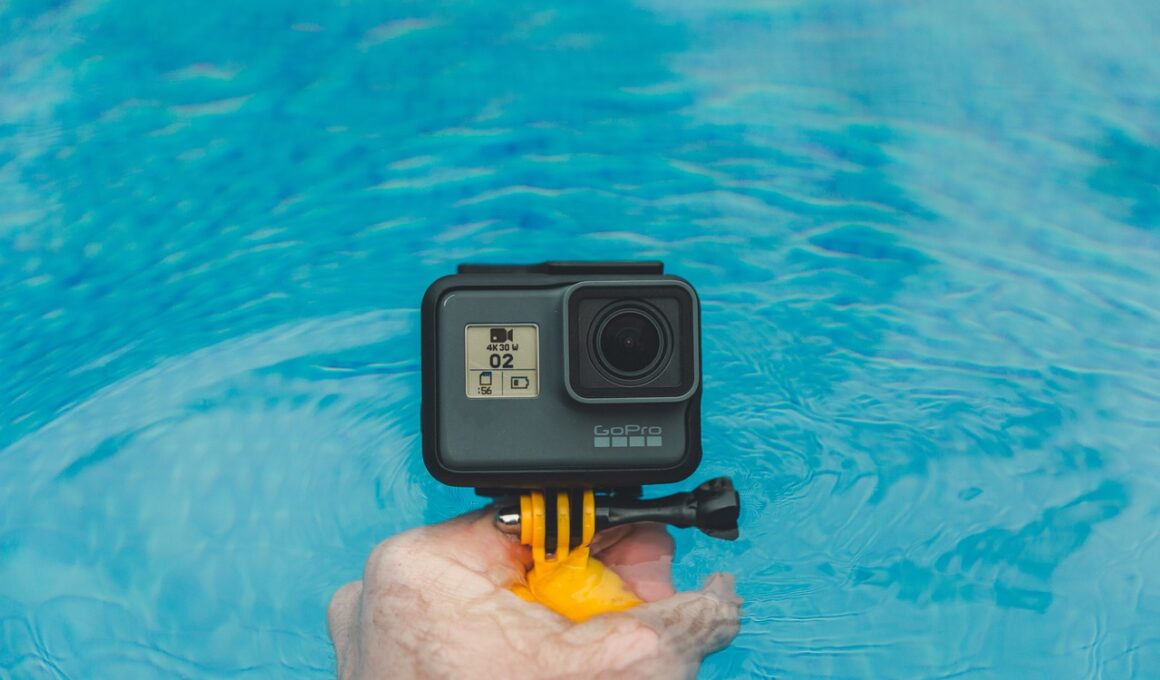How to Compose the Perfect Swimming Shot
Capturing breathtaking swimming shots requires careful consideration of several factors. First and foremost, lighting plays a crucial role in any photograph. The best time for swimming photography is during the golden hour, which is the hour after sunrise or before sunset. During this time, the light is soft and warm, creating a beautiful ambiance that elevates photos. Additionally, pay close attention to the background elements in your shots. A cluttered background can take the focus away from your subject and lessen the impact of your image. Opt for locations with contrasting colors or less busy scenes to enhance your shots. Furthermore, consider your camera settings carefully to adjust for glowing waters and quick movements. A higher shutter speed will freeze action clearly, which is especially essential for competitive swimming scenarios. Lastly, try different angles and perspectives, like underwater shots or low angles, to bring a unique touch to your swimming photography. Experimenting with these elements will help develop your style and improve the quality of your swimming shots significantly.
Next, be mindful of composition when framing your swimming photographs. Think of the rule of thirds to guide the positioning of your subject within the frame. Placing the swimmer off-center can create a more dynamic image that captures the energy of the moment. Another effective technique is to use leading lines in your composition. Lines such as lanes, pool edges, or body movements can lead the viewer’s eye directly to your subject. This method emphasizes the swimmer’s movement and enhances the photo’s overall flow. Additional focus on facial expressions and body positioning can give more depth to the images. A capture of concentration or joy on the swimmer’s face can speak volumes about the moment. Additionally, frame your shots intentionally by including relevant context around the swimmer, such as spectators or coaches, to add storytelling elements. Gathering a variety of shots, from portraits to action poses, enriches your sports photography portfolio significantly. As you practice these techniques, stay aware of how they interact to ensure each image tells a compelling story about the sport and its athletes.
Utilizing Equipment Effectively
To take your swimming photography to an advanced level, understanding your equipment becomes essential. A quality camera is vital for capturing high-speed action in water. DSLRs and mirrorless cameras are both excellent choices due to their superior autofocus capabilities and low-light performance. However, lenses are equally important. A versatile zoom lens allows for flexibility while capturing swimmers, whether they are close to the edge or further away. Consider a lens with image stabilization to minimize blur, especially in challenging shooting conditions. Furthermore, using an underwater housing for your camera can open up a new realm of photography possibilities by allowing you to shoot from beneath the water’s surface. This unique perspective can add creativity and artistry to your photos. Don’t forget about accessories like tripods and monopods to stabilize your camera during shooting. Both help ensure sharp images, particularly in low-light conditions. Remember to regularly check your settings too, including ISO, aperture, and white balance, to adapt to ever-changing water conditions while ensuring clear captures throughout the day. These tools and techniques will significantly enhance your swimming photography outcomes.
Another integral aspect of swimming photography is timing. Anticipating the right moment significantly contributes to capturing the perfect shot. Knowing the swimmer’s routine, including their starts, turns, and finishes, gives you an edge in achieving impactful photographs. Watch for moments like a powerful dive or a victorious finish, ensuring you are ready to capture these special instances. Using continuous shooting mode can also be beneficial, allowing you to take multiple frames per second. This way, you have a higher chance of getting that precise moment of action. Furthermore, understanding swimmer’s strokes can help you predict dynamics during the race, enabling you to focus on capturing significant moments. Allow yourself to immerse in the atmosphere to identify emotional turns as well—the elation of winning or the frustration of losing can provide compelling storytelling in your images. Additionally, communicate with athletes beforehand to understand their favorite moments during a competition. This information can lead to better preparation, ensuring you are always in the right place at the right time for those memorable captures.
Post-Production Techniques
After capturing your swimming photographs, post-production work is essential to polish your images further. Start with sending your photos through editing software like Adobe Lightroom or Photoshop. Begin by adjusting exposure, contrast, and brightness to bring life to the images while enhancing colors to reflect the vibrant atmosphere found in swimming environments. Cropping may also be necessary to remove distractions or to adhere to the rule of thirds for a more dynamic composition. Use sharpening tools to enhance details, especially in areas focused on such as the swimmer’s face and features. Retouching can improve skin tones and remove distractions like stray water droplets, but ensure edits are subtle to maintain authenticity. Furthermore, consider creating presets for your editing process. Presets can help achieve a consistent style across your photography portfolio, giving it a more professional appearance. Lastly, don’t hesitate to experiment with different filters or effects that complement the spirit of the images. Post-production is where your creative vision truly comes to life, turning solid shots into stunning pieces of art ready for publication.
Networking within the swimming community is a critical step for photographers striving to build their presence. Engage with swimmers, coaches, and teams regularly to develop connections that can lead to opportunities. Sharing your work on social media platforms dedicated to sports and swimming can help showcase your style to a broader audience. Platforms like Instagram and Facebook Groups allow you to join communities that appreciate similar interests. Don’t shy away from participating in local competitions and events, as this provides avenues to meet swimmers and other photographers. Take advantage of social media by tagging individuals featured in your shots, and they will likely share your work within their networks, increasing visibility. Additionally, consider collaborating with swim teams for promotional shots or training camps for visibility and experience. Offering to create content can provide exposure as a photographer while building your portfolio. Through consistent networking and participation in community events, you can establish yourself as a respected figure within the swimming photography field.
Conclusion
In conclusion, photographing swimming effectively involves a balance between technical understanding and creative artistry. Mastering lighting, composition, and timing are fundamental skills every photographer should focus on developing. Beyond these basics, utilizing the right equipment and grasping post-production techniques can elevate your work significantly. Don’t underestimate the power of networking and collaboration within the swimming community, as they play a vital role in showcasing your work and finding opportunities. Every photographer must embrace trial and error, experimenting with various techniques to discover their unique style. As you progress on your swimming photography journey, remember the importance of storytelling through your images. Capture the emotions, the competition, and the beauty of the sport through your lens; these components will resonate with audiences and create lasting impressions. With practice, continued education, and dedication, you will develop your swimming photography into a portfolio that reflects the sport’s spirit, and you will be able to share the magic of swimming through your captivating shots.



